Jackson Mark. Machining with Abrasives
Подождите немного. Документ загружается.

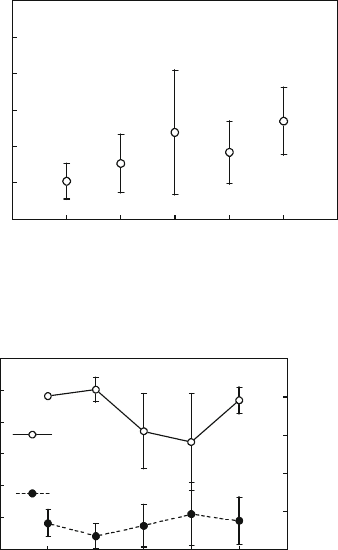
insertion loss of 0.07 dB on average. Alcohol, propylene glycol diamond and
water-based alumina suspensions produced acceptable insertion losses, which are
twice of that for silica suspension. Water-based diamond suspension resulted in the
highest insertion loss, with the maximum value higher than 0.3 dB. The results show
that suspensions have a significant effect on the geometrical quality and the optical
performance of the polished connectors. Using silica suspension gave the best
geometrical quality, including the finest fiber and ferrule surface finish, the smallest
fiber height and the comparable radius of curvature and apex offset, and hence the
best optical performance of the acceptable return loss and the significantly small
insertion loss. Alumina suspension did not offer an advantage over alcohol in terms
of both geometrical and optical qualities. Diamond suspensions did not provide
better results either in terms of geometrical parameters and optical losses.
Better optical performance of a fiber-optic connector results from the well-
polished connector end face. This is because better fiber and ferrule surface finish,
smaller fiber height and apex offset, and reasonable radius of curvature of polished
connect end faces could provide a better physical contact between the two mated
connectors for optical communication.
0
100
200
300
400
500
600
ABCDE
Linear Apex Offset (mm)
Suspension Type
Fig. 8.23 Effect of
suspension on the linear apex
offset of polished fibres
0
10
20
30
40
50
60
0
0.2
0.4
0.6
0.8
1
ABCDE
Return Loss
Insertion Loss
Return Loss (dB)
Insertion Loss (dB)
Suspension Type
Fig. 8.24 Effect of
suspension on optic
performance
8 Polishing Using Flexible Abrasive Tools and Loose Abrasives 365
In summary, with the judicious selection of polishing parameters and protocol,
the efficiency for polishing physical contact connectors can be improved at least
30%. The best polishing process involves only two-step polishing with a total cycle
time of 1 min. To achieve return loss of < 45 dB and insertion loss of <0.3 dB, the
polished fiber and ferrul e surface much have a roughness, R
a
, of smaller than 50 nm,
a fiber height or undercut of 25 or 75 nm, a radius of curvature ranging from 10 to
75 mm, a linear apex offset of smaller than 150 mm and an angular apex offset of
smaller than 0.2
.
8.3 Polishing with Free Abrasives
8.3.1 Polishing of Microbores Using Liquid Suspended
Abrasive Flow
Device miniaturization is one of the frontier technologies in the twenty-first century,
which has brought about completely different ways in which human beings interact
with the physical world. The miniaturization of devices associated with a number of
fields demands for the production of micro-scale mechanical components with
manufactured features ranging from several to several hundred microns with tight
tolerances in a broad range of engineering materials. These fields mainly include
optics, electronics, medicine, bio-technology, communications and avionics.
The rapidly growing needs in making products from macroscopic to nanoscopic
scales from photonic, microelectronic and biomedical industries echoes the inter-
national research direction in modern manufacturing. Micromachining technologies
have attracted great attention of research in the fabric ation of miniaturized industrial
products that are extensively applied into our society [34–45].
In the making of the miniaturized products, a common challenge is from the
fabrication of microbores of diameters ranging from several tens to several hundreds
of microns. The microbore are a typical feature in various products, such as fluidic
filters, grids, bio-medical filters, ink-jet printer nozzles, fuel injection nozzles,
optical ferrules, high-pressure orifices, standard defects for testing materials, micro-
pipettes, pneumatic sensors and manipulators, guides for wire-bonders and spinning
nozzles, and fuel injection nozzles [34]. Great research efforts have been directed
towards developing the micromachining technologies for microbores in the past two
decades. Among them, micro electrical discharge machining (EDM) [40–42] and
laser machining [43–45] have been widely used. Other technologies for such
applications include microcutting [39, 46], ultrasonic machining [47], microforming
and micromolding [48], micro electro-chemical-machining (ECM) [34] and
micropunching [49]. There exist certain limitations in those technologies in terms
of capability of handling various materials and surface finish of micro bores. For
example, micro-EDM is only capable for making holes on conductive or semi-
conductive materials. Laser machining has limitation to obtain microholes with
366 H. Huang et al.
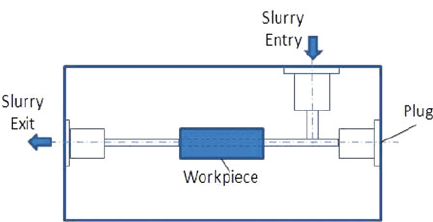
large (length/diameter) aspect ratios. For major ity of the technologies mentioned
above, bore surface quality is not satisfactory and a final finishing process is still
required to meet a stringent quality requirement on microbores.
The challenges for polishing microbores are obvious. Bores are so small that
conventional polishing tools cannot be manipulated inside the holes, so does the
characterization of machined surface quality. Consequently, non-conventional
methods for tooling, machining and char acterization must all be developed. Polish-
ing using a slurry flow is one of the useful methods for polishing microbores [50–52 ].
In this section, we introduce an abrasive flow technology developed for polishing
microbores. The bore diameter investigated varied from 260 to 500 mm and the
length-diameter ratio ranged from 25 to 50. Both metal and ceramic materials
were investigated. Three-dimensional characterization methods involving stylus
profilometry and optical interferometry were also employed to investigate the
effects of flow parameters on inner wall surface roughness and topography.
8.3.1.1 Experimental Appar atus and Worki ng Principle
The experimental apparatus consists of a motor-driven hydraulic pump that is
capable of generating pressure up to 40 MPa, a direction control valve, a hybrid
cylinder, a work unit, two pressure gauges and a slurry tray. In this work, hydraulic
oil 32 is pressurized in the drive power unit and supplied to the hybrid cylinder
through a manually operated directional control valve, which pushes abrasive slurry
going through a microbore to be polished. As illustrated in Fig. 8.25, the workpiece
is precisely aligned in the work unit. The pre-filled abrasive slurry is forced to flow
through the microbore, which is defined as one polishing pass. When one polishing
pass is finished, the used slurry flows to a tray and fresh slurry is added to the
slurry portion of a hybrid cylinder for the next pass of polishing. O-rings are doubly
inserted between the two ends of the workpiece in order to avoid leaking of slurry
under high flow pressure.
Abrasive flow polishing is in fact a slurry flow in turbulent flow regime through a
microhole [53]. The critical Reynolds number for turbulent flow was 2,300 in this
Fig. 8.25 Illustration of slurry flowing route
8 Polishing Using Flexible Abrasive Tools and Loose Abrasives 367

case, which was calculated using the equation [54]: R
e
¼UD/n, where R
e
is the
Reynolds number, U the mean velocity in m/s, n the kinematic viscosity in m
2
/s and
D the hydraulic diameter in meters. In the apparatus developed , U varied from 12 to
29 m/s, n was kept at 1.1 10
6
m
2
/s, and D ranged from 260 to 500 mm. So the
Reynolds number varied from 8,390 to 9,090, much higher than the critical number
of 2,300 for turbulent flow.
The test materials selected include 304 stainless steel, S45C steel and partially
stabilized zirconia. All the specimens have a cylindr ical shape with a leng th of
13.6 mm and outer diameter of 6 mm. Diameters of bores are 500 mm for stainless
steel specimens, 400 and 500 mm for S45C and 260 mm for zirconia. The bores in
specimens made of stainless steel and steels were drilled, but the holes in zirconia
specimens were formed by micro injection molding. Polishing conditions are
summarized in Table 8.6. The pressure in abrasive flow polishing was kept constant
at 10 MPa. Polishing slurry used alumina abrasives of grit size of 17.5 mm with a
concentration of 3.44 vol.%. Flow speeds applied were 19.3 m/s for the 500 mm
holes, 25 m/s for the 400 mm holes and 35.5 m/s for the 260 mm holes. Polishing
passes of 5, 10, 15 and 20 were used.
8.3.1.2 Surface Characteristics and Roughness of Polished Bores
Figure 8.26 show the inner wall surfaces for the stainl ess steel specimens.
Figure 8.26a is the typical surface produced by drilling as the drilling marks are
observed and the surface has long grooves parallel to the drilling direction . When
pressurized abrasive slurry passes the hole, the plastic groove s are worn awa y due
to impact of abrasive particles. The drilling marks are gradually diminished when
the polishing pass is increased, as shown in Fig. 8.26b–d.
Figure 8.27 shows the inner wall surface changes of S45C steel with bores of
500 mm in diameter. Similar to stainless steel specimens, the bores were first drilled.
As shown in Fig. 8.27a, the drilled surface is rough, but the drilling grooves are not
apparent. The surface finish after five polishing passes appears to be improved
Table 8.6 Polishing
conditions
Workpiece (13.6 mm in length,
6 mm in outer diameter)
304 stainless steel, 500 mm
inner diameter
S45C steel, 400 and
500 mm inner diameters
Zirconia, 260 mm inner
diameter
Abrasive flow Alumina of grit size of
17.5 mm
Concentration: 3.44 vol.%
Pressure: 10 MPa
Solution: water
368 H. Huang et al.
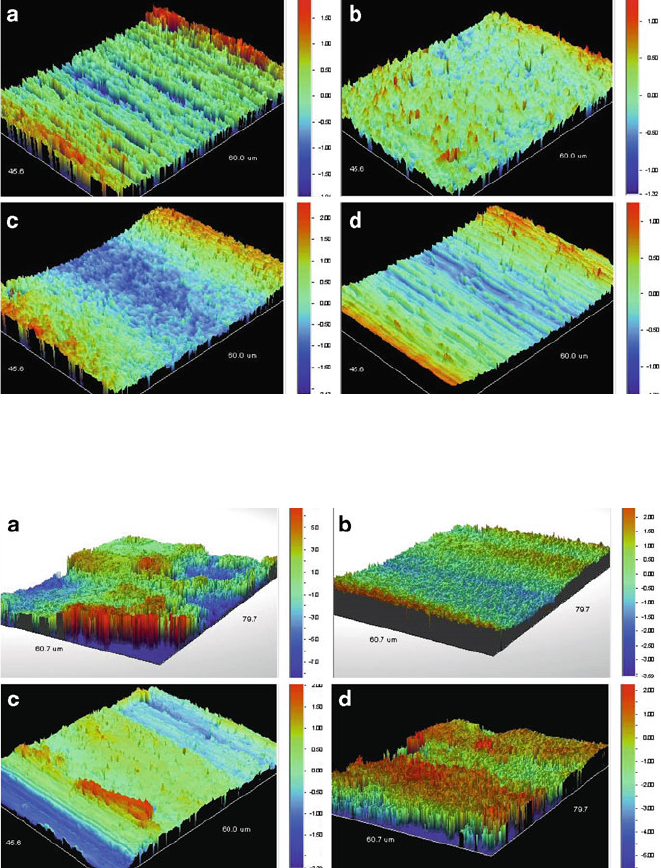
significantly, as can be seen in Fig. 8.27b. After that, the surface finish improves
continuously and gradually with the progress of polishing, as shown in Fig. 8.27c, d.
For comparison, the inner wall surfaces of S45C steel with bores of 400 mmin
diameter is shown in Fig. 8.28. The initial surface of inner wall of the bore in
Fig. 8.26 White light interferometer images of inner wall surfaces of 304 stainless steel
specimen (500 mm in diameter) (a) prior to and after different abrasive polishing of (b)5,(c)10
and (d)15 passes
Fig. 8.27 White light interferometer images of inner wall surfaces of S45C steel specimen
(500 mm in diameter) (a) prior to and after different abrasive polishing of (b)5,(c) 10 and
(d) 15 passes
8 Polishing Using Flexible Abrasive Tools and Loose Abrasives 369
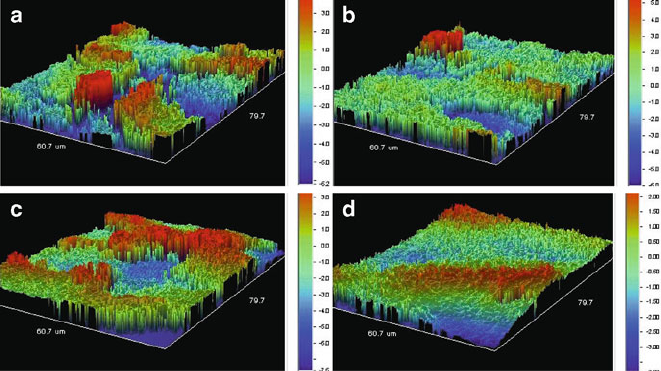
Fig. 8.28a appears to be discontinuous and rough, similar to that of the 500 mm inner
wall in Fig. 8.27a. Figure 8.28b–d show that the wall surface finish is gradually
improved with the increasing polishing pass. However, the roughness improvement
is slower than that in the polishing of microbores with greater diameters.
Figure 8.29 shows the inner wall surfaces of zirconia specimens with bores of
260 mm. In Fig. 8.29a, the powder-injection moulded bore surface after sintering
exhibits to have defects, such as porosity. Pores are randomly distributed in the
zirconia material. Apparently, porosity would contribute to the surface roughness
measured. It is difficult to remove the pores via polishing. As shown in Fig. 8.29b, a
relatively large pore of about 20 mm in diameter is observed on the wall surface
after polished five passes. However, there are no pores observed on the bore
surfaces polished 10 and 20 passes, as shown in Fig. 8.29c and d. It is also clear
that an increase in polishing pass results in a much smoother surfaces.
Values of surface roughness of stainless and S45C steels with bores of 500 mmin
diameter are plotted against polishing pass in Fig. 8.30. There is a significant
difference in their initial surface roughness, with the S45C steel having a much
rougher surface than the stainless steel after drilling. After five polishing passes,
their surfaces become quite similar in terms of roughness. Further polishing
improves the surface finish, but with very limited improvement. It is apparent
that at the late stage of polishing, the trends of surface finish improvement for the
two materials become similar. The surface roughness of stainless steel bores drops
from 1.58 to 0.48 mm, with 70% of improvement after 20 polishing passes.
However, the roughness of S45C steel bores reduces from 4.02 to 0.78 mm after
20 passes, with a more significantly improvement rate.
Fig. 8.28 White light interferometer images of inner wall surfaces of S45C steel specimen
(400 mm in diameter) (a) prior to and after different abrasive polishing of (b)5,(c) 10 and
(d) 15 passes
370 H. Huang et al.
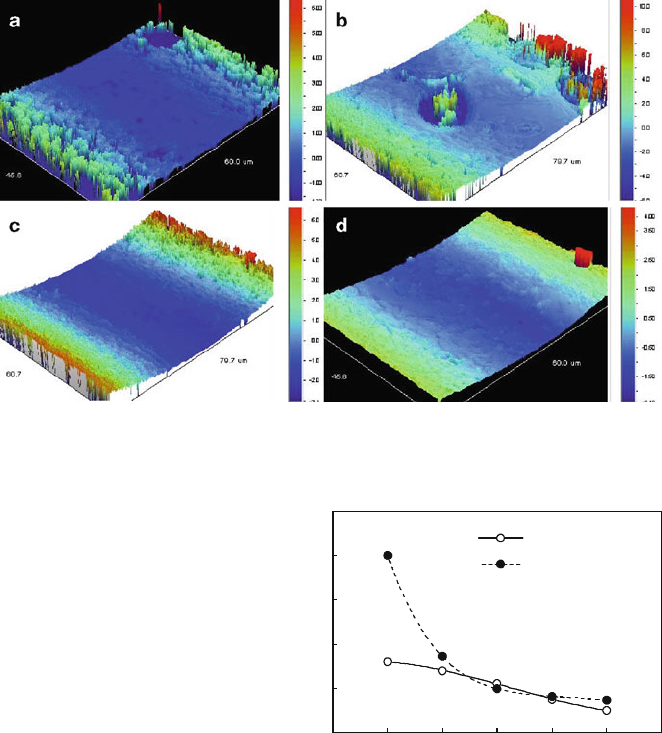
The values of surface roughness of the S45C steel bores of 400 and 500 mmin
diameters are compared and shown in Fig. 8.31, together with the roughness values
of zirconia bores. It is seen that the starting surface roughness for the larger S45C
bore is much greater than that of the smaller bore. However, after polishing the
surface of the larger bore is more significantly improved than the smaller bore with
the progress of polishing. This suggests that the bore diameter plays important role
during polishing. In the polishing processes studied, both the flow pressure and the
flow volume per pass were kept constant, leading to different abrasive flow speeds
of 19.3 and 25 m/s for 500 and 400 mm bores, respectively. Though the average
Fig. 8.29 White light interferometer images of inner wall surfaces of zirconia specimen (260 mm
in diameter) (a) prior to and after different abrasive polishing of (b)5,(c) 10 and (d) 20 passes
0
1
2
3
4
5
0 5 10 15 20
Stainless steel
S45C steel
Roughness, R
a
(
m
m)
Flow Pass (times)
Fig. 8.30 Average surface
roughness plotted as a
function of polishing pass for
different materials. Bore
diameter ¼500 mm
8 Polishing Using Flexible Abrasive Tools and Loose Abrasives 371
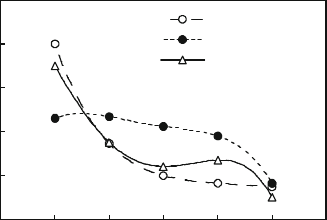
velocity was greater for the smaller bore, however, its velocity gradient dropped
more sign ificantly. In other words, the abrasive flow velocity near the wall surface
in the smaller bore could still be lower. This means that the polishing of a smaller
bores is more difficult. The improvement of surface roughness of zirconia bores is
significant too, decreasing from 3.5 to 0.5 mm after 20 polishing passes. The
decreasing rate of roughn ess is similar to that of the S45C of 500 mm bore though
its bore diameter is only 260 mm. This suggests that a different material removal
rate existing in S45C steel and zirconia, with the later more easily to be removed in
the abrasive flow polishing process.
The results shown in Figs. 8.30 and 8.31 indicate that abrasive flow polishing can
significantly improve the inner wall surfaces of stainless steel, S45C steel and
zirconia bores of less 500 mm inner diameters. The surface roughness for all the
materials investigated is reduced with the progress of polishing, yielding at least
60% improvement in surface finish. The roughn ess decreasing rate appears to be
relevant to both bore size and mater ial.
Based on the results from the topographic analyses in Figs. 8.26–8.29, it is clear
that the material removal in the polishing of stainless steel, S45C steel and zirconia
is mainly due to abra sion. The abrasive flow polishing process developed can be
considered as a lapping operation where abrasive slurry becomes a self-forming
grinding stone as it proceeds through the inner wall of the microbores [54–56]. The
maximum load that can be applied to the abrasive slurry is the cross sectional area
of the restricting inner area multiplied by the applied pressure. Some of this force is
consumed in pushing the abrasive slurry onto the inner wall and in getting the slurry
flow through the inner wall (i.e. friction). The remaining force is applied to the
cutting grains of abrasives at the interface between the abrasive slurry and the inner
wall surfaces. The abrasive flow polishing finishes surfaces by forcing abrasive
slurry through microbores with high pressure. The pressurized slurry interacts with
the inner wall surface of the microbores, thus eroding bore material gradually.
During polishing, the abrasive particles suspended in the slurry first erode away the
sharp spots on the wall surface, thus yielding a more uniform, reliable and smooth
surface. The material removal is thus gentle and uniform, like honing the inner wall
0
1
2
3
4
5
-50 510152025
S45C, 500
m
m
S45C, 400
m
m
ZrO
2
, 260
m
m
Roughness, R
a
(mm)
Flow Pass (times)
Fig. 8.31 Average surface
roughness plotted as a
function of polishing pass for
different bore diameters
372 H. Huang et al.
surfaces. Bores of various materials, such as soft steel, stainless steel and ceramics,
can be successfully polished using this technology.
In summary, the abrasive flow polishing demonstrates to be a feasible technique
for polishing microbores made of stainless steel, mild steel and ceramic material.
It can be certainly used to polish microbores of 260 mm or larger. The surface
roughness of the polished microbores decreases with the increase in pass of slurry
flow, but the improveme nt is gradually slowed down. The polishi ng efficiency
appears to be relevant to bore material and bore diameter, but less dependent on
their initial surface status.
8.3.2 Polishing of Free-Form Component with Free Abrasives
In manufacturing industries, numerous components of free forms that need to be
machined and polished. Those components normally have a complex shape, which
is not well defined. There are stringent quality requirement on surface finish,
however, almost no demand in terms of geometric accuracies. A copper plated
egg component is a typical component in this category. The copper plated eggs are
formed using an electroplating technique, which first forms a layer of copper with a
thickness of 1–2 mm surrounding real egg shells. After forming, abrasive belt
polishing and buffing are required prior to the final gold plating. In the production,
the polishing/buffing processes of copper eggs are manually performed. A highly
skilled worker can only polish 60 components or buff 30 components each day.
In addition, as the belt polishing and buffing requires very skillful operators, the
maintaining of consist quality is of great challenge. The automation of the grinding
and buffing processes has thus become significant.
In this section, we report a study of the finishing processes using tumbling
polishing with free abrasives for free-f orm copper components. The study focuses
on the development of tumbling methods, which includes a detailed investigation of
the effects of polishing variables, such as mill type, abrasive type and mesh size and
the rotation speed, on the polishing efficiency and surface finish.
8.3.2.1 Tumbling Method and Apparatus
Tumbling has been extensively used in mineral processing for refining mines and
particles. The process involves numerous collisions among the mines or particles
charged in a tumbling container or tumbler, which refines or breaks the mines and
particles. In the polishing process that uses the tumbling method, abrasives are
charged into a container together with components to be machined. The collisions
between the abra sives and the components will erode the unnecessary material of
the components away and polish the component surface. Apparently, this method
can handle workpieces with irregular shapes. The energy level of collisions can be
controlled by adjusting the tumbling conditions.
8 Polishing Using Flexible Abrasive Tools and Loose Abrasives 373
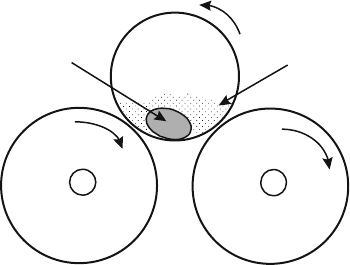
The tumbling equipment used here include laboratory ball mills, which is
slightly different from the conventional one in the mining industry. Smaller and
softer (plastic) containers are used to avoid the damage caused by the collision
between the components and container wall. Three types of tumbling mills are used
for polishing free-form copper eggs, which are described as follows.
The schematic illustration of a typical tumbling mill is shown in Fig. 8.32. The
mill consists of two rollers and a cylindrical container. The roller A is driven by an
electric motor with adjustable rotational speeds and the roller B is free for rotation
along the axis. The container C is freely put on the gap between the two rollers and
it is driven to rotate by the roller A. The free-fo rm components and abrasives
charged in the container thus rotate or move alongside their own trajectories, being
dependent on the rotation speed of the container. The workpiece material can be
removed by micro-cutting, micro-ploughing, micro-grooving or fatigue cracking,
which is determined by the component material and energy level of collision due to
the relative movements of the components and abrasives, resulting in different
polishing effect.
A planetary mill is another type of tumbling mill. It involves the rotational
movement of a container about two separate parallel axes, analogou s to the motion
of the earth around the sun. As illustrated in Fig. 8.33, the planetary container that is
charged with the components and abrasives rotates about the point A, at the same
time, also rotates about the axis O of itself. This results in a complex movement to
both component and abrasives. As a very high rotational speed of the container can
be operated, the energy level of the planetary mill is much higher than that of the
tumbling mill. Thus the planetary mill can be used for the applications that requires
relatively larger material removal.
The vibratory mill has the simplest structure for tumbling. As shown in Fig. 8.34,
a container charged with components and abrasives as is loaded on a vibrating
platform, which is sinusoidally driven by a slider-crank mechanism with an electric
motor. The components and the abrasives also vibrate inside the container. The
relative motions between them produce the polishing effect. Polishing efficiency
and production capacity can be controlled by adjusting the frequency and amplitude
of the moving platform.
AB
C
copper egg
abrasives
Fig. 8.32 Illustration of
tumbling method for polishing
free-form component
374 H. Huang et al.
